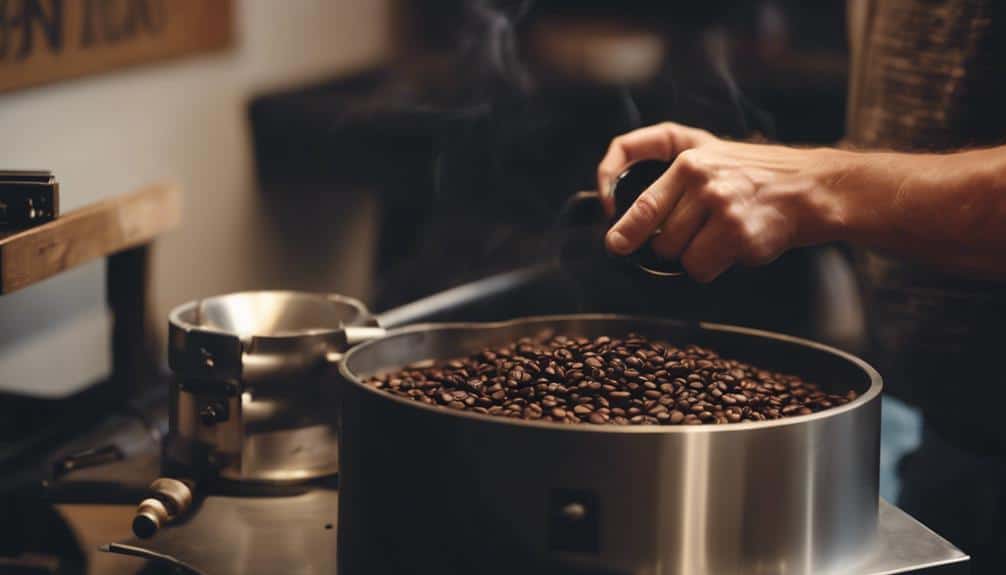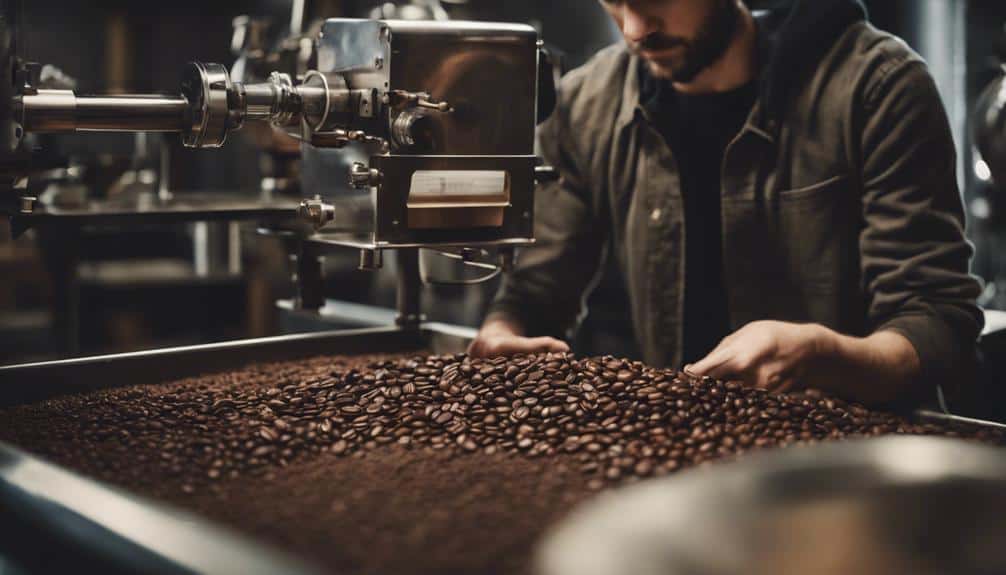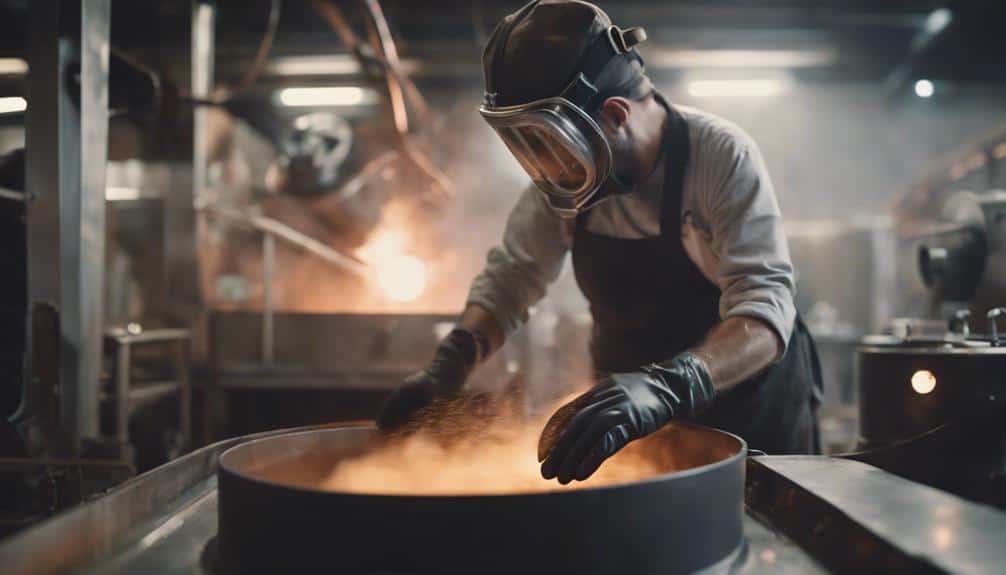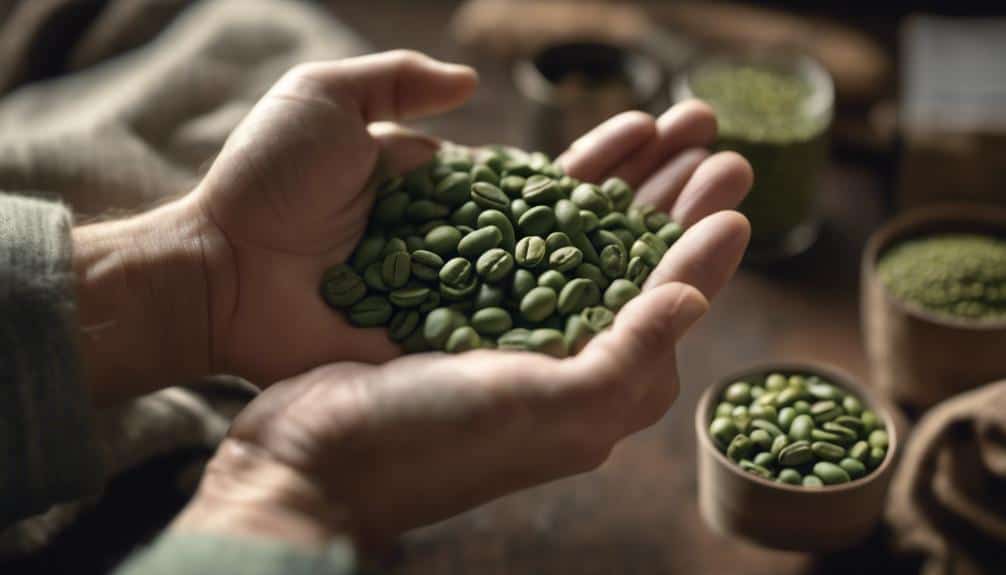Beginners Guide to Mastering At-Home Coffee Roasting

As someone who enjoys a great cup of coffee, mastering the art of at-home coffee roasting can be a rewarding journey. The aroma, the flavors, the process – it all comes together in a way that is both satisfying and intriguing. Exploring different roasting methods and understanding the nuances of each stage can lead to a deeper appreciation for the craft. But what truly sets apart a novice from a connoisseur in this domain? Let's uncover the secrets that can elevate your home roasting game to new heights.
Why Home Roasting Coffee Is Rewarding
Roasting coffee at home, personally crafting each batch, offers me a rewarding journey into the depths of flavor exploration and mastery. The ability to start with green coffee beans and tailor the roast levels to my preference is empowering. Home coffee roasting allows me to experiment with various flavor profiles, from fruity and floral to rich and chocolatey, all through my unique roasting style. One of the most significant advantages is the control over the roast date, ensuring that each cup is at the peak of freshness.
Understanding roast profiles and the roasting process is key to revealing the full potential of every bean. Delving into the intricacies of the roasting process not only yields a superior cup of coffee but also deepens my appreciation for the craftsmanship involved. Each batch roasted at home becomes a reflection of my dedication to quality and a tribute to the artistry of coffee.
Understanding Coffee Bean Roasting Process
Embarking on the journey of home coffee roasting reveals a fascinating world of transformation within coffee beans, starting with the intriguing process of understanding the stages that shape their flavorful destiny.
As green beans enter the roasting chamber, they go through a drying stage where moisture content diminishes, laying the foundation for what's to come. The beans then progress from a yellowing phase to the browning stage, where important chemical reactions occur, influencing the flavor profile.
The first crack indicates a shift from the browning stage, suggesting the beans' readiness. Subsequently, the second crack brings in darker roasts, resulting in reduced acidity levels.
To excel in the art of roasting at home, one must grasp these roasting stages intricately, as they hold the key to controlling the final coffee product's flavor. By understanding and manipulating these stages, one gains the freedom to customize their coffee's taste to perfection.
Exploring Different Roasting Methods

I'm thrilled to explore the diverse world of coffee roasting methods with you.
From using a popcorn maker for a fun and efficient roasting experience to mastering oven roasting techniques for a controlled process, and even experimenting with the rustic charm of a cast-iron skillet – each method brings a unique touch to your home roasting adventures.
Get ready to discover the nuances and flavors that different roasting methods can reveal in your coffee beans.
Roasting With a Popcorn Maker
Exploring the art of using a popcorn maker for coffee roasting reveals an important and engaging method that promises a consistent roast with practice and close attention to detail.
The popcorn machine's ability to agitate the beans evenly contributes to achieving a more uniform roast, making it an excellent choice for beginners.
To master this method, it's vital to monitor the roast carefully and adjust based on the desired outcomes. Initially, you may encounter varying results, but with dedication and practice, you can hone your skills for a perfect roast every time.
Embracing the flexibility and creativity that come with popcorn maker roasting allows for a rewarding journey into the world of at-home coffee roasting.
Oven Roasting Tips
For peak coffee roasting results in the oven, preheat to 500F and ensure proper ventilation to manage smoke effectively. When roasting your beans at home, these tips will help you achieve a perfect roast every time:
- Stir the beans evenly: Guarantee even roasting by stirring the beans in the oven every 5 minutes.
- Use a baking sheet: Opt for a baking sheet to promote even heat distribution during roasting.
- Monitor closely: Keep a close eye on the beans to achieve your desired roast level and prevent scorching.
- Proper ventilation: Maintain good airflow to manage smoke and ensure a pleasant roasting experience.
With these tips, you can master the art of oven roasting and enjoy freshly roasted coffee at home.
Using a Cast-Iron Skillet
Using a well-seasoned cast-iron skillet for coffee roasting at home offers a traditional and effective method for achieving consistent and flavorful roasts. The high heat capabilities of a cast-iron skillet make it ideal for outdoor use to prevent smoke buildup in the kitchen.
Continuous stirring is important to guarantee an even roast, as the beans can easily scorch if left unattended. After roasting, be sure to promptly remove the chaff to prevent any unwanted flavors in your brew.
Due to its size and capacity, a cast-iron skillet is best suited for small batch roasting, allowing for better control over the roast profile. Embracing the cast-iron skillet method can lead to a satisfying and uniform roast, perfect for the coffee enthusiast seeking a hands-on approach to their coffee experience.
Safety Tips for At-Home Roasting

When it comes to at-home coffee roasting, safety is paramount. Ensuring fire prevention measures are in place, setting up proper ventilation, and understanding equipment safety guidelines are essential steps to safeguard yourself and your surroundings.
Fire Prevention Measures
As a home coffee roaster, ensuring a safe roasting environment is paramount to prevent potential fire hazards. Here are some essential fire prevention measures to keep in mind:
- Ventilation is Key: Proper ventilation is vital to manage the smoke and chaff produced during roasting.
- Keep a Fire Extinguisher Handy: Always have a fire extinguisher nearby in case of emergencies.
- Start Outdoors: Begin your roasting journey outdoors to better understand the smoke and chaff levels.
- Clear Surroundings: Make sure there are no flammable materials near your roasting setup to avoid accidents.
Proper Ventilation Setup
To maintain a safe roasting environment and prevent potential fire hazards, guaranteeing proper ventilation setup is key for at-home coffee roasting enthusiasts. Ventilation plays an essential role in directing smoke outside, maintaining good air quality, and removing chaff particles during the roasting process.
Installing a vent hood or using a fan can help achieve this. Roasting near an open window or in a well-ventilated area not only reduces the risk of inhaling harmful fumes but also prevents excessive heat buildup. Good ventilation enhances the overall roasting experience by keeping the air clear and fresh.
Prioritizing proper ventilation in your roasting setup ensures a safer and more enjoyable coffee bean roasting journey.
Equipment Safety Guidelines
Ensuring the safety of your at-home coffee roasting equipment is paramount for a worry-free and enjoyable roasting experience. When it comes to roasting coffee at home, following equipment safety guidelines is vital. Here are some essential tips to keep you safe:
- Use a fire extinguisher as a safety precaution during home coffee roasting.
- Roast in a well-ventilated area to minimize smoke exposure and guarantee safety.
- Keep flammable materials away from the roasting equipment to prevent accidents.
- Start by roasting outdoors to understand the smoke and chaff levels produced.
Selecting the Right Green Coffee Beans

When starting your journey of at-home coffee roasting, the key to success lies in carefully selecting the finest green coffee beans available. The quality of the green beans you choose is essential; it's more vital than the price you pay.
To guarantee your beans stay fresh for longer, store them in cool, dark, and airtight containers, as they can maintain their freshness for 1-2 years.
Sweet Marias is a highly recommended source for top-quality green coffee beans, offering a wide range of varieties for you to experiment with and discover different roasting styles.
By trying out various green coffee bean types, you can uncover a world of flavors and aromas, making your at-home coffee roasting experience truly unique and exciting.
Mastering Roast Levels and Profiles
Exploring the nuances of roast levels and profiles reveals a world of depth and complexity in your coffee roasting journey. Understanding the impact of temperature and time on the beans is key to mastering the art of roasting your own coffee.
Here are some essential points to ponder:
- Light Roast: Retaining the original bean flavors and acidity, light roasts offer a bright and lively cup that showcases the beans' inherent qualities.
- Medium Roast: Balancing acidity and body, medium roasts bring out more complex flavors while maintaining a certain level of brightness in the cup.
- Dark Roast: Featuring bold, smoky flavors and reduced acidity, dark roasts deliver a rich and intense coffee experience that's full-bodied and robust.
- Roast Profiles: These profiles impact the aroma, body, and overall taste of the coffee, allowing you to tailor your roast to suit your preferences and desired flavor profile. Experimenting with different roast levels and profiles is where the true artistry of coffee roasting shines.
Essential Equipment for Coffee Roasting

As we navigate through the intricacies of home coffee roasting, one fundamental aspect that demands our attention is the selection of the right equipment for this flavorful journey. When it comes to roasting your coffee beans at home, having the proper tools can make all the difference. For beginners, options like the Fresh Roast SR800 or SR540 Home Coffee Roaster are excellent choices. These machines offer features like multiple heat levels, temperature controls, and large roasting chambers, making them ideal for those starting out on their roasting venture.
If you prefer a more hands-on approach, using a cast-iron skillet or a Whirley Pop popcorn popper can also yield fantastic results. The cast-iron skillet method requires continuous stirring and careful attention to roast level, while the Whirley Pop popper offers consistent agitation with its hand crank. Whichever equipment you decide to use, it's important to take into account factors such as batch size, heat control, and cooling features to guarantee a successful and enjoyable roasting experience.
Tips for Perfecting Roasting Techniques
What key elements contribute to the art of perfecting roasting techniques for at-home coffee enthusiasts? Mastering the roasting process requires attention to detail and a passion for experimentation. Here are some tips to help you perfect your roasting techniques:
- Understand the Stages of Roasting: Familiarize yourself with the stages such as yellowing, browning, first crack, and second crack to know when to adjust heat levels for best flavor development.
- Properly Cool and Degass Beans: After roasting, make sure proper cooling and allow for degassing to enhance the coffee's flavor profile. Patience is key here, as waiting at least 12 hours before brewing will yield superior results.
- Experiment with Roasting Temperatures: Try different roasting temperatures and levels to create unique and balanced flavors in your coffee beans. This experimentation will help you find the perfect roast for your taste preferences.
- Explore Different Roast Types: Investigate light, medium, and dark roast types to understand how each impacts the coffee's flavor and aroma. Documenting your experiences with each roast type in a journal will help you track progress and improve your roasting skills over time.
Storing and Preserving Freshly Roasted Coffee

When it comes to storing freshly roasted coffee, the key lies in keeping it away from heat, light, and moisture to maintain its vibrant flavors.
Using air-tight containers such as mason jars or vacuum-sealed bags is vital to preserve the coffee's freshness and shield it from oxidation.
Selecting the right storage solution and being mindful of moisture exposure are essential steps to make sure your coffee stays at its peak for longer.
Air-Tight Storage Solutions
Ensuring the longevity of your freshly roasted coffee's exquisite flavors demands meticulous attention to air-tight storage solutions. Here are some key points to contemplate:
- Air-tight containers: Preserve freshness by shielding roasted coffee from oxygen, light, and moisture.
- Proper storage: Prevents flavor degradation, maintaining peak taste for extended periods.
- Ideal options: Vacuum-sealed bags or mason jars help extend the shelf life of roasted coffee.
- Storage environment: Keep roasted coffee in a cool, dark spot away from heat sources to uphold its quality.
Avoiding Moisture Exposure
To safeguard the exquisite flavors of your freshly roasted coffee, it is essential to prioritize avoiding moisture exposure through proper storage techniques. Moisture is a formidable foe when it comes to preserving the quality of your coffee beans. Exposure to moisture can lead to a rapid deterioration of flavor and freshness, resulting in a lackluster coffee experience. By storing your roasted beans in airtight containers, you create a protective barrier against moisture infiltration, ensuring that your coffee maintains its peak taste for longer periods. Utilizing opaque, airtight containers or valve-sealed bags is vital for optimal preservation. Remember, proper storage is the key to prolonging the freshness and flavor of your beloved home-roasted coffee beans.
| Storage Tips | Benefits |
|---|---|
| Airtight Containers | Prevents moisture exposure |
| Opaque Packaging | Protects from light exposure |
| Valve-sealed Bags | Preserves aroma and freshness |
| Proper Storage | Maintains peak flavor |
| Moisture Protection | Ensures quality coffee |
Proper Container Choices
For preserving the exceptional flavors of freshly roasted coffee, selecting the right container is important. When it comes to home roasting, storage containers play a significant role in maintaining the coffee's quality.
Here are some key container choices to help preserve your coffee's flavor and freshness:
- Choose airtight containers with one-way valves to release CO2 without letting air in, ensuring freshness.
- Opt for glass containers with rubber seals or mason jars to store roasted coffee away from light and moisture.
- Consider vacuum-sealed bags or containers with zip locks for short-term storage to retain flavor and aroma.
- Store your coffee in a cool, dark place, away from heat sources and sunlight, to protect it from flavor degradation and maintain its quality.
Troubleshooting Common Roasting Mistakes

Regularly stirring the beans during the roasting process is essential to avoid inconsistencies in the roast. The first and much important step in mastering at-home coffee roasting is to keep a close eye on the beans' moisture content. It's necessary because important chemical reactions happen during this phase. If the beans have varying levels of moisture, you might end up with an uneven roast, impacting the flavor profile.
Another common mistake to stay away from is overheating the beans. This can lead to burnt flavors and unpleasant aromas in your final cup. Additionally, ensuring proper ventilation during the roasting process is crucial. Ventilation issues can greatly affect the overall taste and quality of your roasted coffee beans.
Conclusion
Mastering at-home coffee roasting is a rewarding journey filled with endless possibilities for discovering your perfect cup of coffee.
By understanding the roasting process, experimenting with different methods, and selecting quality beans, you can reveal a world of flavors and aromas right in your own kitchen.
With practice, patience, and a love for coffee, you can enhance your home roasting experience and enjoy the freshest, most flavorful coffee every day.
Happy roasting!





